Deer are majestic creatures, revered for their grace, intelligence, and (of course) their antlers. As a hunter, attracting these wary prey to your hunting ground can be a strategic challenge. But what if you could create a reliable food source that practically guarantees deer activity in your zone? Enter deer feeders! These innovative tools provide a steady stream of sustenance, drawing deer in for a chance encounter.

But with a variety of feeder options available, choosing the right one can feel overwhelming. Fear not, fellow hunter! This comprehensive guide will unveil the best deer feeders on the market, categorized to suit your specific needs. So, grab your gear, and let’s get ready to attract some trophy bucks!
Overview of 7 Best Deer Feeders
1. WILDGAME Deer Feeder with Digital Timer
Automatic
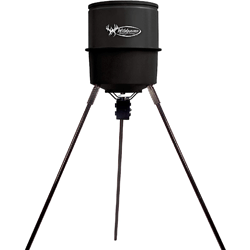
⚙ Product Specifications
- Capacity: 225 lbs
- Radius: Up to 30 feet
- Feed Times: Digital with 1-4 programmable
- Varmint-Proof: Varmint Vault Technology
- Construction: Powder-coated legs & a galvanized steel spinner plate
- Feeder Battery: 6V Tab Style Rechargeable Battery
2. Moultrie Deer Feeder Tripod
Best Overall
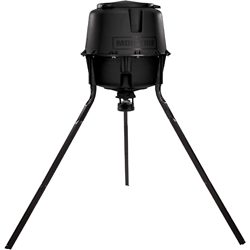
⚙ Product Specifications
- Capacity: 200 lbs
- Radius: Covers a 360-degree casting are
- Feed Times: Varies by model
- Varmint-Proof: Electric varmint guard
- Construction: Green polymer with heavy-duty steel legs
- Feeder Battery: 4 AA batteries
3. WILDGAME Quick-Set Bucket Deer Feeder
Best Budget
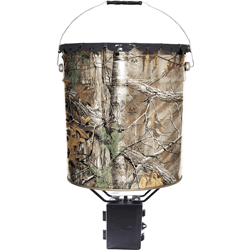
⚙ Product Specifications
- Capacity: 50-pound
- Feed Times: 1-2 available feed times
- Feed Radius: 30-foot radius
- PCell Timer: Making it easy to set feeding schedules
- Hanging Pail Design
4. Moultrie All-in-One Hanging Deer Feeder
Easy To Setup
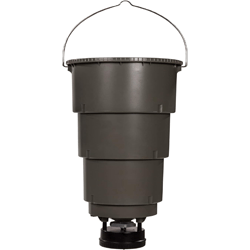
⚙ Product Specifications
- Capacity: 30-pound
- Feed Times: 1-4 available feed times
- Feed Radius: 30-foot radius
- Battery: 4 AA batteries
- Construction: It includes a collapsible plastic bucket
- Hanging Pail Design
5. BOSS BUCK Deer Feeder
Lightweight
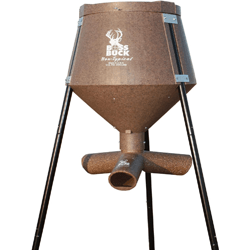
⚙ Product Specifications
- Capacity: 200-pound
- Feed Type: Gravity feed system
- Feed Radius: 20-foot radius
- Feed Dispersion: 3-Way inner sleeve allows control over feed flow
- Construction: Made of tough roto-molded plastic
6. Moultrie Pro Hunter Hanging Feeder
Premium One
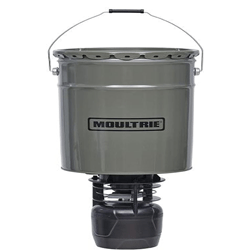
⚙ Product Specifications
- Capacity: 40 lbs
- Radius: Up to 40 feet
- Feed Times: Programs up to 10 feed times per day
- Battery: 6V Battery
- Construction: Powder-coated bucket & a galvanized steel spinner plate
- Hanging Pail Design
7. Gravity Mounted Deer Feeder
Weatherproof
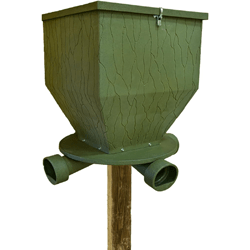
⚙ Product Specifications
- Capacity: 300-pound
- Feed Type: Gravity feed system
- Feed Radius: 20-foot radius
- Weatherproof: Designed for outdoor use
- Construction: Polyethylene (PE) plastic
- Feed Ports: You can control the flow of feed
Related Post:- Best Deer Calls to Increase Your Hunting Success
Related Post:- List Of 35 Deer Hunting Gear Checklist
1. WILDGAME Deer Feeder with Digital Timer
Automatic

⚙ Product Specifications
- Capacity: 225 lbs
- Radius: Up to 30 feet
- Feed Times: Digital with 1-4 programmable
- Varmint-Proof: Varmint Vault Technology
- Construction: Powder-coated legs & a galvanized steel spinner plate
- Feeder Battery: 6V Tab Style Rechargeable Battery
★Key Features
- Large Capacity: Holds 225 lbs of corn or pellet feed, minimizing refills.
- 30-Foot Feed Radius: Attracts deer and other game animals over a wide area.
- Digital Timer: Programmable for up to 4 feed times per day in 5, 10, 15, or 20-second durations, allowing you to control feeding times strategically.
- Durable Construction: Built with heavy-duty coated legs and a galvanized steel spinner plate for long-lasting use in outdoor environments.
- Quick Assembly: Easy to set up in just 15-20 minutes, making it convenient to move and test in different locations.
✔ Pros
- Affordable
- Easy to set up
- Easy to program timer
- Replacement digital timer is excellent
❌ Cons
- Battery box is small
- Timer only lasts 2-3 years
- Plastic drum around legs can crack after 4 years
The Wildgame Innovations Quick-Set 225 lb Game Feeder is a user-friendly feeder designed to attract deer and other game animals. It boasts a large 225 lb capacity for corn or pellet feed, minimizing refills. The standout feature is the digital timer allowing you to program up to four feeding times per day, strategically controlling game animal visits. The feeder is built with sturdy, coated legs and a galvanized steel spinner plate for long-lasting use in outdoor environments. Assembly is straightforward, taking around 20 minutes. An intuitive timer makes setting feeding times a breeze, and a built-in funnel ensures accurate feed dispersal.
While the feeder offers reliable service, some users have reported replacing the timer after extended use. Wildgame Innovations provides a superior replacement option with a metal housing for enhanced durability. The plastic drum can also be reinforced with liquid nails for extended life. For even longer-term use, the leg mounts can be repurposed to construct a feeder using a heavy-duty steel 55-gallon drum (steel drum and additional parts sold separately).
Overall, the Wildgame Innovations Quick-Set 225 lb Game Feeder is a dependable and feature-rich solution for attracting game animals. The user-friendly design, programmable feeding options, and optional long-term use solutions make it a practical choice for hunters seeking to enhance their hunting experience.
2. Moultrie Deer Feeder Tripod
Best Overall

⚙ Product Specifications
- Capacity: 200 lbs
- Radius: Covers a 360-degree casting are
- Feed Times: Varies by model
- Varmint-Proof: Electric varmint guard
- Construction: Green polymer with heavy-duty steel legs
- Feeder Battery: 4 AA batteries
★Key Features
- Easy, Tool-Free Setup: Utilizes Moultrie’s Quick-Lock technology for attachment to the hopper, requiring no tools.
- Digital Timer: Programs up to 4 feed times per day, each lasting 1-20 seconds.
- Wind-Resistant Metal Spin Plate: Galvanized steel construction ensures consistent feed distribution and resists wind interference.
- External Power Port: Allows connection to Moultrie’s solar panel or feeder power panel (sold separately) for extended battery life.
- Feed Level Estimator: Helps gauge how long the feeder can operate before needing a refill based on programmed feeding times.
- Battery Powered: Uses 4 AA batteries (not included) for operation. Can also be used with lithium batteries for extended life and with Moultrie’s solar panel or feeder power panel (sold separately).
✔ Pros
- Quick and tool-free setup with Quick-Lock technology
- Durable metal spin plate ensures reliable feed distribution
- Programmable digital timer offers flexibility in feeding schedule
- Large 30-gallon hopper reduces the frequency of refills
- Feed Level Estimator prevents unexpected refill shortages
❌ Cons
- Timer may require replacement every 2-3 years
- Limited feed time options compared to higher-end models
- Some users found the battery box size inadequate
Introducing the dependable solution for hassle-free feeding – the Automatic Feeder for Deer, Dogs and Wildlife. Designed to provide consistent and reliable feeding for your furry friends or as a convenient deer feeder option, this product ensures your pets or wildlife get the nourishment they need without any hassle.
Say goodbye to worries about accidental resets or interruptions in feeding schedules. Unlike traditional feeders, this automatic feeder features a sturdy construction that keeps it stable even when bumped or jostled. Whether it’s your energetic dog or curious cat, rest assured that this feeder will continue to dispense food as programmed.
With its adjustable height legs and durable design, this feeder is suitable for various environments and conditions, including windy areas. The easy-to-use programmable settings allow you to customize feeding times and portions according to your preferences, ensuring your pets or wildlife are well-fed on schedule.
Assembly is a breeze with no missing parts, and the sleek design makes it a welcome addition to any outdoor setting. Plus, the feeder operates on standard AA batteries, providing convenient and long-lasting power without the need for frequent replacements.
Whether you’re looking for a reliable solution to feed your dog or seeking an effective deer feeder option, this Automatic Feeder is the perfect choice. With its versatility, durability, and ease of use, it’s a must-have for any pet owner or wildlife enthusiast. Invest in peace of mind and ensure your beloved pets or wildlife always have access to the nourishment they need with this top-quality feeder.
3. WILDGAME Quick-Set Bucket Deer Feeder
Best Budget

⚙ Product Specifications
- Capacity: 50-pound
- Feed Times: 1-2 available feed times
- Feed Radius: 30-foot radius
- PCell Timer: Making it easy to set feeding schedules
- Hanging Pail Design
★Key Features
- Compact Design: Smallest feeder in the Quick-Set line, ideal for smaller spaces.
- Easy to Attract Game: Despite its size, effectively attracts and patterns deer and other game animals.
- Simple Timer: User-friendly PCell timer allows programming for 1-2 feeding times per day.
- Feeder Versatility: 50 lb capacity accommodates both corn and protein pellets, letting you choose the feed your game prefers.
- Quick Setup: Pail design facilitates assembly in just 5 minutes, minimizing time spent setting up and maximizing time observing game activity.
- Portable: Lightweight and easy to move, allowing you to find the perfect feeding location.
- Durable Construction: Features a sturdy 6.5-gallon pail, a galvanized steel spinner plate for feed distribution, and a Realtree Xtra camo barrel for optimal concealment.
✔ Pros
- Easy setup
- Attracts deer (2-6+ per evening)
- Durable (4+ years with annual battery change)
- Raccoon-proof
- Great value
❌ Cons
- Unidentified model (limited feature details)
- Unknown lifespan (potential for malfunctions after extended use)
“Wow! I can’t say enough good things about the WILDGAME INNOVATIONS Quick-Set Game Feeder. Setting it up was a breeze, and it’s been performing like a champ ever since. I’ve been using a combination of corn and antler-promoting feed, and the results have been outstanding. Each evening, I’ve had anywhere from 2 to 6 deer feeding from it, and the game cam pictures I’ve captured are truly incredible. I only wish I had gotten this feeder at the beginning of hunting season!
What’s truly impressive is the durability of this feeder. I’ve had it out in the woods for a whopping 4 years, and it’s still going strong. Yes, you read that right – 4 years, not just seasons! I simply replace the battery at the start of each hunting season, and it works flawlessly throughout. Plus, it does its job of feeding the deer like clockwork, while those pesky raccoons haven’t been able to get the lid off, keeping the feed secure.
And let me tell you about the customer service. When my feeder recently stopped working after 5 years of faithful service, my hunting buddy took it home, cleaned it up, and replaced the corroded alligator clips. Now, it’s back in action and throwing corn like it’s brand new. Talk about longevity and reliability!
Overall, this feeder has exceeded all my expectations, and it’s easily one of the best purchases I’ve ever made on Amazon. If you’re looking for a reliable feeder to attract game and get some incredible hunting experiences, do yourself a favor and get one of these. You won’t regret it!”
4. Moultrie All-in-One Hanging Deer Feeder
Easy To Setup

⚙ Product Specifications
- Capacity: 30-pound
- Feed Times: 1-4 available feed times
- Feed Radius: 30-foot radius
- Battery: 4 AA batteries
- Construction: It includes a collapsible plastic bucket
- Hanging Pail Design
★Key Features
- All-inclusive kit: Includes feeder, bucket, funnel, and batteries for easy setup.
- Wind-resistant metal spin plate: Ensures consistent feed distribution in windy conditions.
- 5-gallon collapsible bucket: Saves on storage space and shipping costs.
- Built-in funnel: Prevents feed from accumulating at the bottom and sides of the bucket.
- Customizable run times: Allows you to program feeding durations to suit your needs.
- Doubled battery run time (up to 4 months): Provides extended operation in the field.
- Test button: Simplifies setup by allowing you to test feeder functionality before deployment.
✔ Pros
- Reviewer highlights the affordability for the features offered
- No instructions needed for timer programming
- The dispenser successfully attracted squirrels
❌ Cons
- Described as “teeny bit chintzy”
- Tricky to fill
- Parts don’t lock securely
Experience the convenience and value of the Moultrie Hanging Deer Feeder, designed to simplify feeding tasks while offering excellent performance. With its easy setup and user-friendly features, this feeder provides reliable feed distribution for both wildlife and domestic animals.
Upon its first dispensing, the Moultrie feeder surprised even the squirrels with its unique noise, but they quickly adapted, highlighting its effectiveness in attracting animals. While it may have a slight chintzy feel, the feeder’s excellent value for the money earns it a solid five-star rating.
Setting up the timer is a breeze, requiring no instructions, although loading the feed can be a bit tricky. To minimize spillage, it’s recommended to hang the feeder before loading and ensure all baffles are properly aligned. Once these steps are taken, the feeder operates smoothly, dispensing feed with ease.
Whether used for wildlife management or feeding chickens, this feeder proves to be incredibly simple and efficient. Its only minor drawback is that the sections may not always stay locked in place securely, causing occasional top ring collapses during filling. However, this does not detract from the feeder’s overall performance and functionality.
5. BOSS BUCK Deer Feeder
Lightweight

⚙ Product Specifications
- Capacity: 200-pound
- Feed Type: Gravity feed system
- Feed Radius: 20-foot radius
- Feed Dispersion: 3-Way inner sleeve allows control over feed flow
- Construction: Made of tough roto-molded plastic
★Key Features
- Large Capacity: Holds 200 lbs of feed, minimizing refills.
- Dual Feeding System: Gravity feed protein in the Spring & Summer, convertible to an automatic feeder (sold separately) for Fall & Winter.
- Customizable Flow Control: Patented 3-way inner sleeve allows for adjusting feed flow to accommodate various feed shapes and sizes.
- Even Feed Dispensing: Internal cone ensures even distribution of feed to all three ports.
- Weatherproof Design: UV protected, windproof, and waterproof construction.
- Moisture Control: Double-walled hatch lid minimizes condensation and allows the feeder to reach ambient temperature faster than metal or fiberglass alternatives.
- Compact and Portable: Ideal for remote locations with limited access.
- Durable Construction: Made from lightweight plastic with galvanized hardware for long-lasting use.
✔ Pros
- Easy setup and versatile feeding options
- High-quality construction for durability
- Reliable feed distribution for effective wildlife attraction
- Generous capacity reduces refill frequency
- Adaptable design allows for customization
❌ Cons
- Occasional missing hardware in packaging
- Minor alignment issues during assembly
- Risk of over-tightening screws
Experience the convenience and versatility of the Boss Buck 200-lb Gravity Feeder, designed to simplify feeding tasks while offering excellent performance in attracting wildlife. With its user-friendly setup and adaptable features, this feeder provides reliable feed distribution for hunting or wildlife observation.
Setting up the Boss Buck feeder is a breeze, with its easy assembly process allowing you to get started quickly. Additionally, this feeder offers the option to convert to a timer if desired, providing flexibility to suit your feeding preferences.
However, while the feeder itself is of high quality and functionality, there have been some reported issues with missing hardware in the packaging. Although one feeder had all the necessary hardware taped inside the hopper, others were missing components, indicating a need for improvement in packaging and handling processes.
Furthermore, customers have noted that the packaging could be better sealed, as some boxes arrived partially open due to poor tape seals. Despite these minor shortcomings, the feeders perform well once assembled, and users have found solutions to minor alignment issues with the feed tubes and legs.
6. Moultrie Pro Hunter Hanging Feeder
Premium One

⚙ Product Specifications
- Capacity: 40 lbs
- Radius: Up to 40 feet
- Feed Times: Programs up to 10 feed times per day
- Battery: 6V Battery
- Construction: Powder-coated bucket & a galvanized steel spinner plate
- Hanging Pail Design
★Key Features
- Large Capacity: The Moultrie Pro Hunter II Hanging Feeder features a 6.5-gallon metal barrel with a generous 40-lb. capacity, allowing for ample feed storage.
- Comprehensive Feeder Kit: Includes the Pro Hunter II Feeder Kit, equipped with essential components such as a metal spin plate, adjustable funnel, ABS plastic housing, feed-level estimator, battery indicator, and external power port.
- Programmable Digital Timer: The feeder kit’s digital timer allows for precise programming of up to 10 feed times per day, with customizable durations ranging from 1 to 60 seconds each, ensuring optimal feeding frequency and duration.
- Quick-Lock Adapter: Designed for easy installation, the Quick-Lock adapter mounts securely to any barrel or hopper, providing versatile compatibility and hassle-free setup.
- Battery-Powered Operation: Requires only one 6V battery (not included) for power, offering convenient operation without the need for extensive wiring or electrical outlets.
- Durable Construction: Constructed with sturdy materials to withstand outdoor conditions and frequent use, ensuring long-lasting performance and reliability in any environment.
✔ Pros
- Seamless operation for scattering corn
- Digital timer programs
- Allows for mounting on various barrels or hoppers
❌ Cons
- Clogging issues
- Limited feed type
- May require troubleshooting and modifications to address clogging issues
Experience seamless feeding with the Moultrie Pro Hunter II Hanging Feeder, designed to provide reliable and customizable feeding for wildlife and livestock. This feeder boasts a 6.5-gallon metal barrel with a substantial 40-lb. capacity, ensuring ample storage for feed.
Equipped with the Pro Hunter II Feeder Kit, this feeder includes essential components such as a metal spin plate, adjustable funnel, ABS plastic housing, feed-level estimator, battery indicator, and external power port for comprehensive functionality.
The digital timer allows for precise programming of up to 10 feed times per day, with customizable durations ranging from 1 to 60 seconds each, ensuring optimal feeding frequency and duration to suit your needs.
Installation is made easy with the Quick-Lock adapter, which securely mounts to any barrel or hopper, providing versatile compatibility and hassle-free setup. However, it’s worth noting that some users have reported issues with feed clogging in the opening. To mitigate this, modifications such as adding a 10-24 screw to the throw plate may be necessary.
While the feeder works seamlessly with whole kernel corn, users have noted limitations when using other types of feed, such as pig feed. Additionally, for optimal performance, it’s recommended to use a battery with at least 6 Amps to ensure efficient operation, particularly when spraying heavy feed mixes like corn and wheat.
7. Gravity Mounted Deer Feeder
Weatherproof

⚙ Product Specifications
- Capacity: 300-pound
- Feed Type: Gravity feed system
- Feed Radius: 20-foot radius
- Weatherproof: Designed for outdoor use
- Construction: Polyethylene (PE) plastic
- Feed Ports: You can control the flow of feed
★Key Features
- 300-Pound Feed Capacity: This gravity feeder has an impressive 300-pound weight capacity, suitable for holding corn or protein feed, ensuring an ample supply for deer and game.
- Post Mounted Design: Easily mounts onto an 8-foot 4 × 4 (not included), positioned 4-feet into the ground and 4-feet above, facilitating convenient feeding for adult deer without the need for a tripod.
- Damage-Free Rack: Unlike tripod feeders that may interfere with antler growth, the single post design ensures minimal impact on antler development, preserving the potential of future trophy bucks.
- Adjustable Feeding Ports: Fully adjustable feeding ports enable precise control over the flow of feed, allowing you to customize feeding settings according to your preferences and wildlife management goals.
- Weatherproof Construction: Featuring a large, watertight cover, this feeder is designed to withstand the elements, ensuring easy refilling while keeping feed fresh, dry, and secure, regardless of weather conditions.
✔ Pros
- Easy installation on an 8-foot 4×4 post
- Wildlife-friendly single post design
- Adjustable feeding ports for control
- Weatherproof with a watertight cover
- Varmit deterrent options available
❌ Cons
- Continuous access may lead to quicker depletion
- Raccoons may find a way to access the feeder
Optimize your wildlife feeding experience with the Gravity Fed Post Mounted Weatherproof Feed Bank Deer and Game Hunting Feeder. With a substantial 300-pound capacity, this feeder ensures an abundant and consistent food supply for deer and game, eliminating the need for frequent refills.
Designed for convenience and effectiveness, this feeder easily mounts onto an 8-foot 4 × 4 post (not included), positioned at an ideal height of 4 feet above the ground. The single post configuration minimizes interference with antler growth, preserving the potential of future trophy bucks.
Enjoy precise control over feed distribution with fully adjustable feeding ports, allowing you to manage the flow of feed according to your preferences and wildlife management goals.
Crafted from heavy-duty plastic, this feeder boasts durability and resilience against the elements. Its weatherproof design features a large, watertight cover, ensuring easy refilling while keeping feed fresh, dry, and secure, even in harsh weather conditions.
Installation is a breeze with clear and concise instructions provided. Implementing effective techniques, such as tack strips, helps deter squirrels, raccoons, and other varmints, ensuring that the feed remains accessible only to the intended wildlife.
Different Types of Deer Feeders for Every Hunter
1. Gravity Feeders:
These feeders rely on gravity to dispense feed from a hopper as deer consume it below. They’re the most basic and affordable option, requiring no electricity or complex setup.
Pros: Easy to use, low maintenance, cost-effective, works well in remote locations.
Cons: Constant feed availability can lead to overconsumption and waste. May attract unwanted animals like raccoons. Capacity limitations might require frequent refilling.
2. Hanging Feeders:
These feeders suspend from a sturdy tree branch or structure, keeping feed off the ground and minimizing contamination.
Pros: Space-saving design, protects feed from ground moisture, offers good visibility for monitoring deer activity.
Cons: Requires a suitable hanging location, may not be ideal for areas with strong winds, refilling can be inconvenient depending on height.
3. Tripod Feeders:
These feeders feature a three-legged stand that supports a hopper, offering stability and ease of placement.
Pros: Freestanding design doesn’t require hanging, works well in open areas, offers good visibility for deer.
Cons: Can take up more space than hanging feeders, may be susceptible to tipping over in strong winds.
4. Automatic Feeders:
These feeders utilize timers or motion sensors to dispense feed at predetermined times or when deer are present.
Pros: Allows for precise control over feeding times and portions, minimizes waste, reduces spooking deer with frequent refilling.
Cons: Most expensive option, requires batteries or electricity, may require programming and troubleshooting.
5. Protein Feeders:
These feeders are designed specifically for protein pellets, a high-nutrient feed that attracts deer during critical growth and pre-rutting periods.
Pros: Provides targeted nutrition for deer health, can attract deer during specific seasons.
Cons: May require purchasing protein feed separately, may not be suitable for all feeder types.
How To Choose A Quality Deer Feeder
Deer feeders act as magnets, drawing deer to your hunting ground with the promise of a reliable food source. But with a multitude of feeder options on the market, selecting the right one can feel like navigating a dense forest without a compass. Fear not, hunter! This guide will equip you with the knowledge to choose a quality deer feeder that seamlessly integrates with your hunting strategy.
Consider Your Needs:
- Feeding Strategy: Do you want a constant flow of feed (gravity feeder) or controlled portions (automatic feeder)?
- Location: Where will you place the feeder? Is there a sturdy hanging spot for a hanging feeder, or open space for a tripod feeder?
- Budget: How much are you willing to invest in feeder technology?
- Maintenance: Are you comfortable with programming timers (automatic feeders) or refilling feeders frequently (gravity feeders)?
Key Features to Evaluate:
- Capacity: Choose a feeder capacity that aligns with your desired refill frequency and deer population. Larger feeders require less frequent refilling but take up more space.
- Durability: Opt for feeders constructed with weatherproof materials like galvanized steel or UV-protected plastic to withstand harsh elements.
- Varmit Resistance: Look for feeders with features that deter raccoons and other critters, such as lids with latches or metal skirts around the base.
- Ease of Use: Consider how easy it is to set up, fill, and maintain the feeder. Some feeders require minimal assembly, while others might involve programming timers.
- Power Source: Gravity feeders require no power source, while automatic feeders might utilize batteries or electricity. Consider your access to power in the hunting location.
Additional Considerations:
- Timer Options: Automatic feeders with multiple timer settings allow for precise control over feeding times, minimizing waste and spooking deer with frequent refilling.
- Camera Compatibility: Some feeders integrate with trail cameras, allowing you to monitor deer activity remotely.
- Warranty: A good warranty indicates the manufacturer’s confidence in the product’s quality and durability.
Beyond the Feeder:
Remember, the best feeder is only one piece of the puzzle. Here are some additional tips to optimize your deer feeding strategy:
- Feed Type: Choose high-quality feed that attracts deer and complements their natural diet. Consider corn, protein pellets, or a mix depending on your goals.
- Feeder Placement: Position the feeder in an area with good cover and natural deer trails, allowing for easy access and a sense of security for the deer.
- Supplemental Feeding Practices: Start feeding early in the season to establish a feeding routine. Monitor feed levels and adjust feeding times as needed.
By carefully considering your needs, evaluating feeder features, and implementing smart feeding practices, you’ll select a quality deer feeder that transforms your hunting ground into a haven for these magnificent creatures. Now go forth, equip yourself with the perfect feeder, and prepare to witness the thrill of a successful hunt!
Frequently Ask Questions:-
1. What are the best deer feeders for attracting wildlife?
The best deer feeders often depend on factors such as your budget, property size, and local wildlife preferences. Gravity-fed feeders like Moultrie Feed Station or Texas Hunter EZ Fill are popular choices for their simplicity and reliability. Electronic feeders such as the Moultrie Pro Magnum Tripod offer programmable timers and adjustable settings for precise feeding schedules.
2. How do I choose the right deer feeder for my property?
When selecting a deer feeder, consider factors such as capacity, durability, ease of use, and local regulations. Assess your property size and terrain to determine whether a tripod, hanging, or ground feeder would be most suitable. Additionally, think about the type of feed you plan to use and whether the feeder can accommodate it effectively.
3. Are gravity-fed or electronic deer feeders more effective?
Both gravity-fed and electronic deer feeders have their advantages. Gravity-fed feeders are typically more straightforward and require less maintenance, making them ideal for remote locations or areas with limited access. Electronic feeders offer programmable features that allow you to schedule feedings at specific times, which can be beneficial for attracting deer during optimal hunting times.
4. What features should I look for in a top-rated deer feeder?
Look for deer feeders with features such as durable construction, weather resistance, adjustable feed settings, and varmint protection. Opt for feeders with UV-resistant materials to withstand harsh outdoor conditions, and consider models with built-in timers or photocell technology for reliable feeding schedules.
5. Can you recommend budget-friendly deer feeders that still deliver results?
Yes, several budget-friendly deer feeders offer reliable performance without breaking the bank. Look for options like the Wildgame Innovations Quick-Set 225 or Moultrie 30-Gallon Pro Hunter Tripod Feeder, which provide sturdy construction and ample capacity at an affordable price point. Additionally, DIY feeder setups using PVC pipes or recycled materials can be cost-effective alternatives for attracting deer to your property.
Leave a Reply